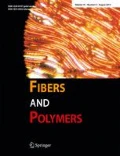Abstract
In this work, a new natural-based approach was exploited to improve the low temperature carrier method in dyeing process of polyester fabrics. Vanilla was introduced as an alternative substitute for commercial toxic carriers including CTM and Levegal PEW in particular. With use of vanilla in dyeing process, the dye uptake of PET fabrics dyed with C.I. Disperse blue 56 and C.I. Disperse Red 1 was increased significantly. In order to have an economical dyeing process, a two-component mixture of carrier and vanilla was assessed to reduce the consumption of carrier (1/6 of optimum amount) and vanilla. The results showed that vanilla and commercial carriers were compatible and so their mixtures led to higher dye uptake compared to each one individually. The study confirmed that vanilla as an eco-friendly material could substitute the use of commercial carriers in polyester dyeing and led to excellent wash, rub, and better light fastness properties.
Similar content being viewed by others
References
J. Dasgupta, J. Sikder, S. Chakraborty, S. Curcio, and E. Drioli, J. Environ. Manage., 147, 55 (2015).
R. Kale, A. Banerjee, and G. Katre, Fiber. Polym., 16, 54 (2015).
S. B. Moore and L. W. Ausley, J. Cleaner Prod., 12, 585 (2004).
M. Albanese, J. Boyenval, P. Marchese, S. Sullalti, and A. Celli, AIMS Mol. Sci., 3, 32 (2016).
T. Hussain, M. Tausif, and M. Ashraf, J. Cleaner Prod., 108, 476 (2015).
M. Kodrić, S. Stojanović, B. Marković, and D. Đorđević, Chem. Ind. Chem. Eng. Q., 23, 131 (2017).
A. Al-Etaibi, H. Alnassar, and M. El-Apasery, Molecules, 21, 855 (2016).
G. Gedik, O. Avinc, A. Yavas, and A. Khoddami, Fiber. Polym., 15, 261 (2014).
K. L. Georgiadou, E. G. Tsatsaroni, I. C. Eleftheriadis, and A. H. Kehayoglou, J. Appl. Polym. Sci., 83, 2785 (2002).
M. A. Iskender, B. Becerir, and A. Koruyucu, Text. Res. J., 75, 462 (2005).
P. Altay, G. Özcan, M. Tekçin, G. Şahin, and S. Çelik, Ultrason. Sonochem., 42, 768 (2018).
Y. Liu, H. C. Kim, and Y. S. Chung, Fiber. Polym., 8, 363 (2007).
S. Dhouib, A. Lallam, and F. Sakli, Text. Res. J., 76, 271 (2006).
M. Schuler, Text. Res. J., 27, 352 (1957).
T. Harifi and M. Montazer, Dyes Pigm., 97, 440 (2013).
G. Roberts and R. Solanki, J. Soc. Dyers Colour., 95, 226 (1979).
L. Reed, V. Büchner, and P. B. Tchounwou, Rev. Environ. Health, 22, 213 (2007).
V. Pasquet, A. Perwuelz, N. Behary, and J. Isaad, J. Clean. Prod., 43, 20 (2013).
B. Mu, H. Xu, and Y. Yang, Color. Technol., 133, 415 (2017).
M. A. Tavanaie, A. M. Shoushtari, and F. Goharpey, J. Clean. Prod., 18, 1866 (2010).
J. Wang, X. Li, F. Ge, Z. Cai, and L. Gu, ACS Sustain. Chem. Eng., 4, 3285 (2016).
F. Carrion-Fite and S. Radei, Eds., “Development Auxiliaries for Dyeing Polyester with Disperse Dyes at Low Temperatures”, IOP Conference Series, Materials Science and Engineering, 2017.
T. H. C. C.Costa, M. C. Feitor, C. Alves, P. B. Freire, and C. M. de Bezerra, J. Mater. Process. Technol., 173, 40 (2006).
S. Ramachandra Rao and G. A. Ravishankar, J. Sci. Food Agric., 80, 289 (2000).
N. J. Walton, A. Narbad, C. Faulds, and G. Williamson, Curr. Opin. Biotechnol., 11, 490 (2000).
L. S. de Jager, G. A. Perfetti, and G. W. Diachenko, J. Chromatogr. A, 1145, 83 (2007).
A. K. Sinha, S. C. Verma, and U. K. Sharma, J. Sep. Sci., 30, 15 (2007).
G. Lamprecht, F. Pichlmayer, and E. R. Schmid, J. Agric. Food Chem., 42, 1722 (1994).
A. K. Sinha, U. K. Sharma, and N. Sharma, Int. J. Food Sci. Nutr., 59, 299 (2008).
E. Cicchetti and A. Chaintreau, J. Sep. Sci., 32, 3043 (2009).
W. G. Galetto and P. G. Hoffman, J. Agric. Food Chem., 26, 195 (1978).
I. Klimes and D. Lamparsky, Int. Flav. Food Addit., 7, 272 (1976).
B. K. Lavine, D. T. Corona, and U. D. N. T. T.Perera, Microchem. J., 103, 49 (2012).
A. Tai, T. Sawano, F. Yazama, and H. Ito, Biochim. Biophys. Acta, 1810, 170 (2011).
N. J. Walton, M. J. Mayer, and A. Narbad, Phytochemistry, 63, 505 (2003).
D. McShan and I. Shah, Comput. Chem. Eng., 29, 499 (2005).
V. Pasquet, A. Perwuelz, N. Behary, and J. Isaad, J. Clean. Prod., 43, 20 (2013).
J. Koh, “Dyeing with Disperse Dyes”, 1st ed., pp.1–28, Textile Dyeing: Intech, Peter Hauser Ed., China, 2011.
S. Shakra, H. Hanna, and A. Hebeish, Angew. Makromol. Chem., 75, 53 (1979).
A. Arcoria, M. L. Longo, and G. Parisi, Dyes Pigm., 6, 155 (1985).
S. M. Burkinshaw, “Chemical Principles of Synthetic Fibre Dyeing”, 1st ed., pp.1–5, Springer Netherlands, 1995.
SDBS I. Spectral Database for Organic Compounds SDBS Japan: National Institute of Advanced Industrial Science and Technology (AIST), 2013.
V. Balachandran and K. Parimala, Spectrochim. Acta Part A: Mol. Biomol. Spectrosc., 95, 354 (2012).
Author information
Authors and Affiliations
Corresponding author
Rights and permissions
About this article
Cite this article
Jalali, S., Rezaei, R., Afjeh, M.G. et al. Effect of Vanilla as a Natural Alternative to Traditional Carriers in Polyester Dyeing with Disperse Dyes. Fibers Polym 20, 86–92 (2019). https://doi.org/10.1007/s12221-019-8482-2
Received:
Revised:
Accepted:
Published:
Issue Date:
DOI: https://doi.org/10.1007/s12221-019-8482-2




